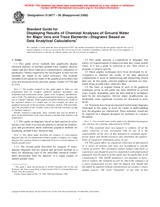We need your consent to use the individual data so that you can see information about your interests, among other things. Click "OK" to give your consent.
ASTM D5877-95(2000)
Standard Guide for Displaying Results of Chemical Analyses of Ground Water for Major Ions and Trace Elements-Diagrams Based on Data Analytical Calculations
STANDARD published on 1.1.2000
The information about the standard:
Designation standards: ASTM D5877-95(2000)
Note: WITHDRAWN
Publication date standards: 1.1.2000
SKU: NS-32917
The number of pages: 18
Approximate weight : 54 g (0.12 lbs)
Country: American technical standard
Category: Technical standards ASTM
Annotation of standard text ASTM D5877-95(2000) :
Keywords:
chemical analysis, chemical ions, graphical display, ground water, ground water quality, statistical analysis, water-analysis diagram, ICS Number Code 13.060.50 (Examination of water for chemical substances)
Additional information
| 1. Scope | ||||||||||
|
1.1 This guide covers methods that graphically display chemical analyses of multiple ground-water samples, discrete values and also those reduced to comprehensive summaries or parameters. Details required by the investigator to fully use the methods are found in the listed references. The methods included in this guide are many of the graphical procedures that were not discussed in two previous guides, Guides D5738 and D5754. Note 1--The graphic methods in this guide
apply to both raw and transformed data, for example, unaltered
medians, maximums, and minimums and transformed means,
square-roots, frequency distributions, and so forth. The methods
are often computational intensive, requiring the use of a digital
computer. Some graphical methods illustrate the results of the
statistical analysis of a sample data set. For example, box plots
are graphical portrayals of the maximum, minimum, median, 25th
percentile, and 75th percentile of one variable, such as the
chloride ion from a group of chemical analyses. 1.2 This guide on diagrams based on data analytical calculations is the third of several documents to inform the hydrologists and geochemists about traditional graphical methods for displaying ground-water chemical data. Note 2--The initial guide described the category of water-analysis diagrams that use two-dimensional trilinear graphs to display, on a single diagram, the common chemical components from two or more analyses of natural ground water. 1.2.1 The second guide described the category of water-analysis diagrams that use pattern and pictorial methods as a basis for displaying each of the individual chemical components determined from the analysis of a single sample of natural ground water. 1.3 This guide presents a compilation of diagrams that allows for transformation of numerical data into visual, usable forms. It is not a guide to selection or use. That choice is program or project specific. 1.4 Many graphic techniques have been developed by investigators to illustrate the results of the data analytical computations to assist in summarizing and interpreting related data sets. In this guide, selected graphical methods are illustrated using ground-water chemistry data. 1.5 The basic or original format of each of the graphical techniques given in this guide has been modified in several ways, largely depending upon the data analytical techniques used by the investigators. Several minor modifications are mentioned, some significant revisions are discussed in more detail. 1.6 Notations have been incorporated within many diagrams illustrated in this guide to assist the reader in understanding how the diagrams are constructed. These notations would not be required on a diagram designed for inclusion in a project document. Note 3--Use of trade names in this guide is for identification purposes only and does not constitute endorsement by ASTM. 1.7This standard does not purport to address all of the safety concerns, if any, associated with its use. It is the responsibility of the user of this standard to establish appropriate safety and health practices and determine the applicability of regulatory limitations prior to use. 1.i This guide offers an organized collection of information or a series of options and does not recommend a specific course of action. This document cannot replace education or experience and should be used in conjunction with professional judgment. Not all aspects of this guide may be applicable in all circumstances. This ASTM standard is not intended to represent or replace the standard of care by which the adequacy of a given professional service must be judged, nor should this document be applied without consideration of a project's many unique aspects. The word "Standard" in the title of this document means only that the document has been approved through the ASTM consensus process. |
||||||||||
| 2. Referenced Documents | ||||||||||
|
We recommend:
Technical standards updating
Do you want to make sure you use only the valid technical standards?
We can offer you a solution which will provide you a monthly overview concerning the updating of standards which you use.
Would you like to know more? Look at this page.




 Cookies
Cookies
